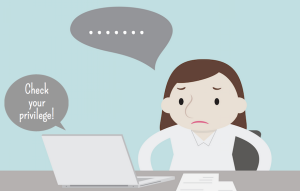
Source: Getty Images
Have you ever wanted to say something to your partner, friend, or family member, but just couldn’t get the words out?
Maybe you were seeing someone for a long time and wanted to figure out if you were or weren’t in a relationship. Or maybe you wanted to tell your sister that you no longer see the world like you did when you were eighteen years old.
No matter the circumstance, saying what you feel can be both what holds you back from getting what you want and what stops you from experiencing the reality of a situation.
It’s not easy to express our feelings a lot of the time, but here are some ideas if you’re itching to begin.
Know That Your Feelings Are Valid
When I look back at the times I couldn’t verbalize my feelings, most often it was because I didn’t believe in them.
I could talk for hours with my friends about what I felt, but when it came time to tell the person I needed to tell, I would retreat and rationalize my reasoning for not saying anything.
”Maybe I’m crazy for thinking this” or “Maybe it really doesn’t matter if I say something” became excuses that I made to myself again and again.
A lot of this came from not having my emotions valued when I was younger, resulting in my casting them aside almost always out of shame. I learned to believe that having emotions was weak, and that was the last thing I wanted to appear.
If you don’t take your feelings seriously, you may find yourself asking others to weigh in on them.
Asking friends if they think you’re crazy for saying something or simply asking what they think about a situation that you’ve already made up your mind about can be an indication that you don’t trust what’s coming up for you.
To start valuing your feelings, you have to start believing in them.
A way to do this is to stop turning to others for emotional advice.
If you feel a certain way or have to make a decision, don’t reach out to others if it isn’t necessary. Instead, think through the emotion on your own – because only you know what’s best for you.
The more you stop listening to others, the more you’ll start listening to yourself.
And the more you listen to yourself, the more you begin to trust and rely on yourself for the answers.
Envision Yourself Saying What You Feel
Now that you can believe in what you feel, you might be bursting at the seams because you so badly want to say something. But the minute you’re face-to-face with whomever you need to address, you freeze.
This is super common.
I’ve revved myself up, told my mirror and my friends that I’m going to say something, and then an hour later, I’m exactly where I started.
What helps in this situation is to visualize the encounter before it happens.
Run through scenarios in your mind of how you want the meeting to go. Write down exactly what you’re planning to say. Practice it in front of a mirror if you have to. Do whatever you need to do to get a good idea of what your hopes are.
And then devise a game plan for what to do if the events don’t go as expected. Think about what that will look like, too.
What’s key here is seeing yourself saying what you feel.
The more you see yourself starting the conversation and engaging in it more comfortably, you’ll be more ready when it happens.
Take a Deep Breath and Jump
You’ve visualized the situation and you have an idea of what it is you want to say, so now it’s time to act on it.
I wish there was some magic word I could tell you to say that would make it easier, but sometimes it’s really up to us to just push ourselves over the ledge and jump.
Take a deep breath. It’s go time.
Sometimes I’ll go to the bathroom, do some inhales and exhales, and talk to myself a bit in the mirror. And what I find myself repeating is what the Nike ad so brilliantly (and ubiquitously) states: “Just do it.”
Sometimes, you have to throw yourself into the unknown. Of course we don’t know what the outcome is going to be, but remember that you may have an opportunity to change your circumstances for the better.
If you stay where you are, things will never change.
You deserve to open doors for yourself and to create new paths. And no matter what the outcome is, you’ll be stronger than you were before because you did it.
How to Start
Things don’t always have to be so serious when dealing with feelings. There are ways to make the situation light enough so it doesn’t feel morbid, but also heavy enough so it doesn’t seem inconsequential.
It doesn’t have to start with “I need to know right now if…”It doesn’t have to start with “Don’t freak out, but…” It doesn’t even have to start with “Can we talk?”
The best way to start and maintain a conversation is to keep it focused on you and your feelings and then at the end ask for what you want to have happen.
Afterward, you can say something like “You don’t have to respond to me now. Take some time to think about it and let me know, but I just needed to let you know how I was feeling.”
The minute it’s out of your mouth – and therefore, off of your chest – you’ll feel a lot better – and probably more confident in yourself than before, too.
—
You may be scared to say what you feel because feeling anything at all is scary. But what’s far more frightening is if you don’t say anything.
If you go on pretending, preferring not to face what you’re thinking and feeling, you’re not setting yourself up to go forward or even backward; instead, you land yourself on repeat.
It’s your responsibility to break the cycle.
And if I could do it, I know you can, too.
Want to discuss this further? Login to our online forum and start a post! If you’re not already registered as a forum user, please register first here.
Cynthia Kane is a Contributing Writer at Everyday Feminism. Cynthia Kane is a Contributing Writer for Everyday Feminism. Over the last year and a half, she’s relearned the following: how to jump up and down when she’s happy, cry when she’s sad, laugh when something’s funny, take a compliment, smile at strangers, and be open to the fact that everyone is going through it all the time. For more, visit her website or follow her on Twitter @cynkane. Read her articles here.
Search our 3000+ articles!
Read our articles about:
Our online racial justice training
Used by hundreds of universities, non-profits, and businesses.
Click to learn more
Most Read Articles
- « Previous
- 1
- …
- 30
- 31
- 32



















